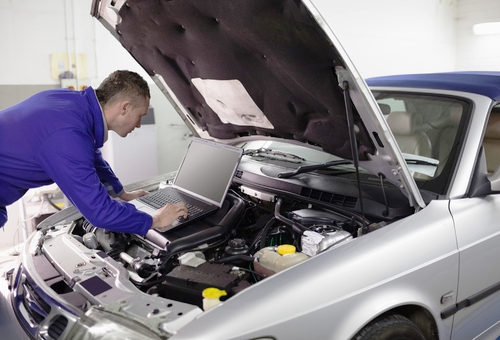
As an experienced technician, you are no doubt aware of the fact that windscreen wipers are not what they used to be, in the sense that on many new models, you can no longer diagnose faults in wiper systems with a simple 12-volt test light. If however, you are newly qualified, or have not had much exposure to electronic diagnostics, you should know that you now need a scan tool to diagnose wiper issues on many new cars, and on some that are not so new. Thus, in this article, we will take a closer look at modern windscreen wiper systems in terms of how they work, and what to look out for when diagnosing faults, starting with this question-
While windscreen wiper blades have not changed much over the past few decades, the mechanisms that drive them have evolved greatly. We are all familiar with the bulky wiper motors and reciprocating arms that are often so difficult to work on, but all that has changed on many makes and models. Now, more and more car manufacturers are switching to computer controlled wiper systems, and while this saves a lot of weight, it adds several layers of complexity to diagnosing and fixing wiper issues.
For instance, since 2013, Ford has been using direct drive systems on Escape, Fusion, and Focus models in which each wiper arm is driven independently by a separate, programmable motor. From a manufacturing perspective, this system has the advantages that it saves weight, uses fewer parts, reduces wiring complexity, and improves wiper efficiency. However, to work as designed, such a system depends on the LIN serial communication system between itself and the body control module (and several other control modules) being fully functional, which from a maintenance perspective could present us with some serious challenges- which begs this question-
Each wiper arm is driven independently by a programmable motor, each of which contains its own electronic management system. In short, each motor contains electronic circuits and position sensors that not only allow each wiper arm’s travel to be programmed independently of the other arm, but also to control wiper speeds, park and service positions, as well as overload protection.
It is perhaps worth noting that although each wiper motor can be programmed and controlled independently of the other, the motor on the driver’s side is always the primary motor that controls the operation of both motors through a second, separate communication circuit to the passenger side motor via the LIN serial communication system. On some models, the windscreen washer pump is also controlled by the primary motor- Fusion and Focus models from 2014 onwards being examples.
As a practical matter though, and although the wiper system is mainly controlled by the body control module, the body control module also receives input data from other control modules on the LIN network to enable speed-sensitive wiper operation, rain or moisture sensor integration, as well as headlight activation when the wipers are activated.
At this point, astute readers will no doubt have recognised some of the potential problems and issues with computer controlled wiper systems, so let’s answer this question-
It has been this writer’s experience that many things can, and do go wrong, some of which are easy to fix, while others are not. Let’s start with some easy-to-fix issues-
Mind your marks
You may find that once you have removed and reinstalled the wiper arms for whatever reason, the wipers behave erratically, or over or undershoot their previous park positions. Here’s why this happens-
Since the wiper motors are not linked in any mechanical way, each motor has to be programmed individually to sweep as much of the windscreen as possible; once this is done, the wipers will behave reliably and predictably. However, removing the wiper arms without following a set procedure upsets this programming, with the result that the wipers may not work, or work unpredictably. Here’s how to prevent that from happening-
Place the wiper arms in the “Locked” position by cycling the wipers through one complete cycle before turning the control switch off, but leaving the ignition in the “ON” position, which allows you to remove the wiper arms for service. However, the wipers will remain locked for only about five minutes before the vehicle enters a battery saving mode, so you might run out of time.
There is a workaround for this though. Factory installed windscreens have alignment marks, which if you use them to reinstall the wiper arms, will prevent erratic wiper behaviour, but aftermarket windscreens do not have these marks. Therefore, you need to mark the positions of the wipers on the windscreen before your five minutes are up, but note that if whatever you are doing takes longer than five minutes, you need to place the wipers in the “Locked” position again before refitting the wiper arms, using the alignment marks you made earlier.
Note though that in some cases, you need to perform a wiper reset or initialisation procedure with a high-end scan tool after the wipers had been in the “Locked” position. Whether or not this is required is make and model dependent, so be sure to consult a reliable source of service information, and if required, perform the procedure before returning the vehicle to your customer.
So now that we have some basic issues out of the way let us look at some specific wiper issues, and how to diagnose or resolve them, starting with-

On Ford F-150, Explorer, and Edge models you may run into code B1131:08, which is defined as “Wiper motor module bus signal failure”, with the most common symptom being that the wipers only work on low speed or in intermittent mode, even if the control switch is in the “OFF” position.
This code is very common on many other Ford models as well, and in its simplest form it indicates a communication failure in the LIN network between the steering column control module and the primary wiper motor.
To resolve this code you need to view the wiper switch PID’s, all of which should read “OFF” when the wiper multi-function switch is in the “OFF” position. If however, one or more PID’s read “ON”, the fault is almost certainly in the multi-function switch. To verify this, switch the ignition OFF and disconnect the steering column control module, and switch the ignition ON again; if the multi-function switch is defective, the wipers will fail to work.
Note though that on most, if not all F-150 models you may need to disconnect the battery to reset the wiper system, even after repairs are complete. This is required because the wiper motors will “remember” their last programming mode before the repair, and may default to that programming unless the battery is disconnected to reset the system to follow new programming.
Note that on all Ford models, the wipers will default to low speed operation in cases where the network control fails completely, regardless of the control switch position. Thus, control of the wiper system via the control switch will only be possible after full network control is re-established.
The most common symptom of this code is that the wipers work continuously as the result of a communication failure in the LIN system between the wiper multi-function switch and the instrument cluster, aka the Cabin Compartment Node, or sometimes, between the switch and the steering control module.
Typically, though, a scan tool will not show communication with the steering control module if code U1149:00 is present and an all module scan is also unlikely to provide clues, beyond the fact that one or more other modules may have stored code U1149:00. Nonetheless, you can unplug the steering control module and physically check the current on the LIN wire, which should carry between 7 and 12 volts. If such a current is present, the fault is almost certainly in the steering control module, which can be replaced on a plug-and-play basis.
This code may be stored in multiple control modules, and indicates that the wiper park switch circuit in one or both wiper motors is high, with the most common symptom being that the wipers work continuously on low speed when the multi-function switch is on the “Intermittent” position.
As a first step to resolving this issue you need to clear the code before cycling the wipers three times. In case the code returns immediately, you need to disconnect the wiper motor to check the voltage at pin A, which has a brown and grey wire. This wire should carry 5 volts, which is supplied by the TIPM*; this circuit is normally grounded when the multi-function switch is in the park position.
If there is no current on this wire but the wire’s resistance is within acceptable limits, replacing the TIPM will usually resolve the issue, but note that reliable service information is required to program the new TIPM.
*The abbreviation “TIPM” stands for Totally Integrated Power Module, which is a sort of distribution box through which almost every electrical system on late model Chrysler vehicles run. As such, the TIPM has the potential to influence almost every operational aspect of a TIPM-equipped vehicle.
However, if you do find 5-volts on pin A, reconnect the motor and turn on the wipers. Back probe pin A with a self-powered test light- if the wiper motor is functional, the test light will flash on and off as the circuit is cyclically grounded as the internal switch opens and closes. If this does not happen, replace the wiper motor.
Although the wiper service position on most makes and models is not usually related to failures or defects in the wiper system, the wiper park position below the level of the bonnet often makes it difficult, if not impossible to replace wiper blades or to perform other services and/or repairs.
On most VW, Audi, and BMW models, you can move the wipers up from the park position and into the service position by pulling the wiper stalk down within 5 seconds of switching off the ignition. On Nissan Juke models however, you need to tap the wiper stalk up twice within 5 seconds of switching off the ignition.
Most other models have similar procedures, and although repair manuals usually do not include this information, user manuals almost always describe how to move the wipers out of park position and into the service position. Fortunately, unlike repair manuals, user manuals for even the latest model vehicles are often available online; you may have to search a bit, but you will usually find user manuals or relevant service information on technical websites like mechanic.com.au, or on one of many online forums that are dedicated to specific makes and models.
It has been this writer’s experience that many customers complain about the fact that the wipers on their vehicles move slightly when they start their vehicles. This is not indicative of a failure, malfunction, or defect in modern wiper systems. In fact, VW, Audi, and many other manufacturers have integrated a feature into their computer controlled wiper systems that moves the wiper arms slightly during start-up. This is normal, and intended to prolong the useful service life of wiper blades by preventing the wiper blades from permanently taking on the curvature of the windscreen while the wipers are in the park or rest position.
While it is true that a scan tool and reliable service information are required to diagnose and repair most wiper related problems on modern vehicles today, it is also true that modern wiper systems are no more complicated than any other system that is controlled by multiple control modules. The same diagnostic procedures that apply to other systems also apply to wiper systems; therefore, if you have a sound working knowledge of LIN-based communications systems and networks, modern computer controlled wiper systems should hold no mysteries for you.